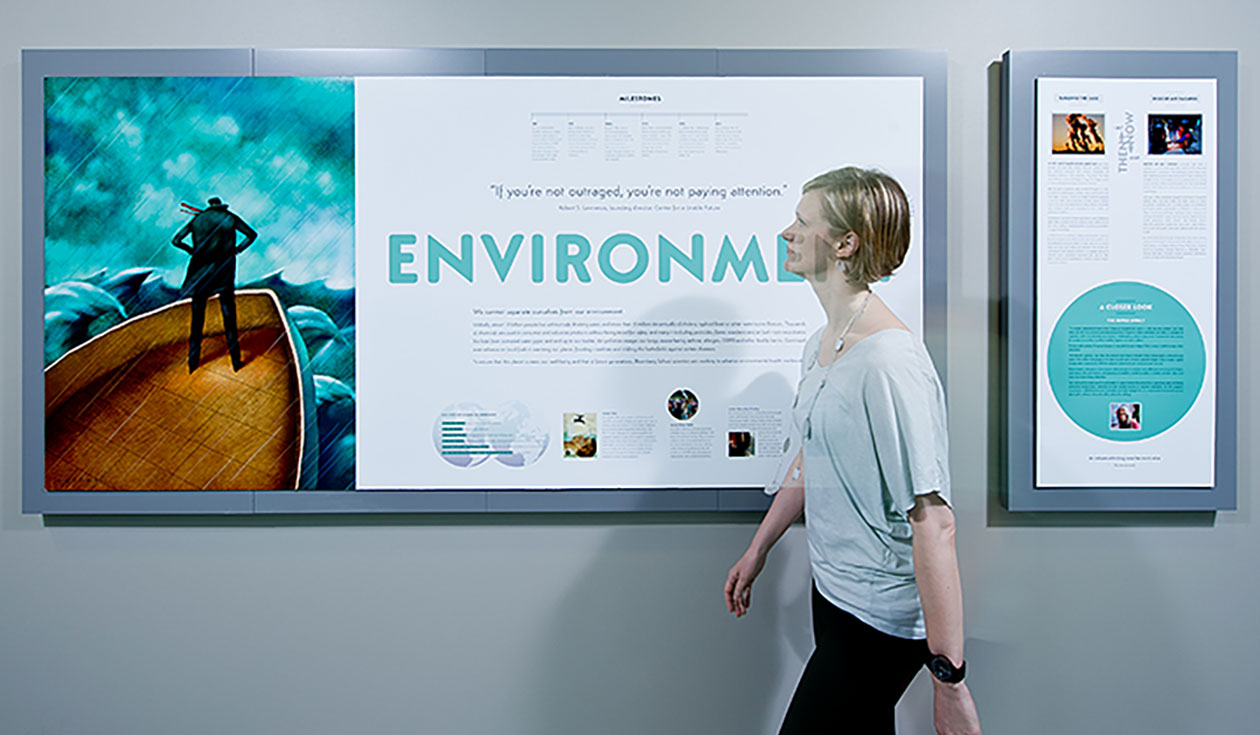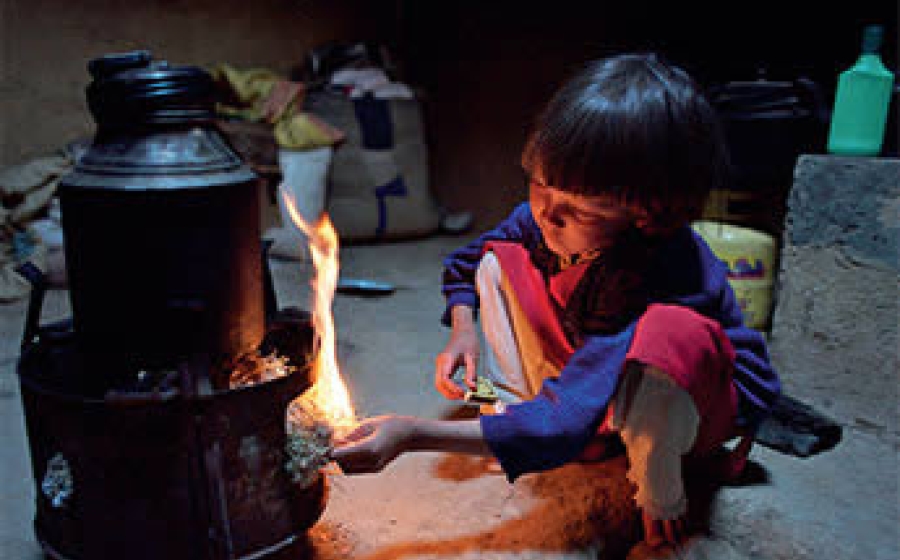Environment

An indispensable thing never has
much value.
Russian proverb
We cannot separate ourselves from our environment.
Globally, about 1.5 billion people live without safe drinking water, and more than 12 million die annually of cholera, typhoid fever or other waterborne illnesses. Thousands of chemicals are used in consumer and industrial products without being tested for safety, and many—including pesticides, flame retardants and jet fuel—join neurotoxins like lead from corroded water pipes and end up in our bodies. Air pollution ravages our lungs, exacerbating asthma, allergies, COPD and other bodily harms. Continued over-reliance on fossil fuels is warming our planet, flooding coastlines and shifting the battlefields against certain diseases.
To ensure that this planet sustains our well-being and that of future generations, Bloomberg School scientists are working to advance environmental health worldwide.
Timeline
1947
1947
The U.S. Atomic Bomb Casualty Commission initiates extensive health studies on survivors of the Hiroshima and Nagasaki bombings; JHSPH trains dozens of Japanese physicians who later conduct the landmark Child Health Survey and other studies.
1951
1951
Anna M. Baetjer, ScD ’24, is among the first scientists to identify the relationship between occupation and lung cancer, showing higher lung cancer rates among workers in industries that use chromium.
1960s
1960s
Richard L. Riley, chair of Environmental Medicine, demonstrates that ultraviolet lamps in hospital air ducts can prevent the spread of tuberculosis via airborne droplets. Riley also develops air purification systems for NASA’s space capsules.
1970
1970
Robert Rubin, an Environmental Medicine faculty member, and student Rudolph J. Jaeger, PhD ’71, find that DEHP, a common plasticizer, moves from blood storage bags into the bloodstreams of transfusion patients.
1972
1972
G. Carleton Ray, a Pathobiology faculty member and an expert on polar marine mammals and population biology, spearheads the passage of the federal Marine Mammal Protection Act—the original “save the whales” law.
2013
2013
Patrick Breysse, PhD ’85, MHS ’80, an Environmental Health Sciences professor, leads a major EPA study that details how air pollution particles induce pulmonary inflammation.
Then & Now

Then: Building the Case
IN 1997, AN ESTIMATED 60,000 AMERICANS were dying annually from particulate pollution. Miniscule particles emitted from fossil-fuel combustion—auto exhausts, smokestacks and backyard barbecues—were ubiquitous. They skirted the body’s natural filtration system and lodged in lungs. The linkage to acute or chronic damage was not yet conclusive, however.
After five years of examining data from the 90 largest U.S. cities, an article by epidemiologist Jonathan Samet and biostatisticians Scott Zeger, Francesca Dominici and Aidan McDermott appeared in the June 2000 National Morbidity, Mortality, and Air Pollution Study. It showed indisputably that particulate pollution is associated with increased deaths and hospitalizations from cardiac and pulmonary conditions.
A subsequent study, led by Samet, examined two years of Medicare patient data, air pollution records, smoking surveys, weather records and census statistics, integrating billions of pieces of information to support the findings.
In 2006, Dominici published in JAMA results of another study that found a strong association between fine particle air pollution and hospitalizations among the elderly. On days when tiny air particle levels were high, more elderly were admitted to the hospital with cardiovascular and respiratory ailments. For example, among the 250,000 seniors hospitalized nationwide each year for heart failure, 3,000 of the hospitalizations could be traced to higher levels of air pollution.

Now: Indoor Air Hazards
INDOOR AIR MAY CONTAIN surprisingly high levels of pollutants—up to 100 times higher than outdoor air. This widespread phenomenon is pervasive in the developing world where wood, plant material and animal waste are burned for fuel in small, poorly ventilated homes. “Since exposure occurs primarily during cooking, women and their children are at the highest risk,” says Shyam Biswal, director of the Indo-U.S. Center of Excellence for Environmental Lung Diseases.
Each year, 3 billion people are exposed to high levels of household pollution from cook-stove smoke, the largest source of indoor air pollution worldwide; and 4.3 million people die prematurely from health conditions attributable to it. Pollutants in indoor smoke inflame the airways and lungs, impairing immune responses and reducing the blood’s oxygen-carrying capacity. Related illnesses include pneumonia, stroke, ischemic heart disease, chronic obstructive pulmonary disease and lung cancer. Some evidence points to low birth weight, tuberculosis, cataracts and other cancers as well.
Biswal also directs the Center for Global Clean Air, which is testing cook-stove technologies and associated health effects in sites across South America, sub-Saharan Africa and Asia. The Center is helping launch an innovative campaign featuring an affordable, clean-burning cook stove. It includes a power source for USB devices, such as LED lights and cell phone chargers.
A CLOSER LOOK

The Ripple Effect
“The complex relationship between climate change and the global food system is a really big, messy problem,” says Cindy Parker, MD, MPH ’00, co-director of the Bloomberg School’s Program on Global Sustainability and Health. To investigate the implications of the interrelationship, she is leading a multidisciplinary research study to track “how food and water scarcity, for example, can contribute to political instability, migration and violent conflicts.”
Existing models estimate a 10-percent decrease in crop yields for every 1-degree Celsius increase in global average surface temperature.
“We think that’s optimistic,” says Parker. The prediction doesn’t factor in broader climate change impacts on the entire food system. With 2 billion more people on the planet by 2050 and a minimum projected 2-degree Celsius increase in global average surface temperature by 2100, the implications of food and water scarcity are much more dire.
Parker’s Hopkins-wide project is harnessing the talents of experts in migration and conflict, food and energy technologies, earth sciences, the social sciences and engineering to establish a scientific foundation to identify and better define food system and climate change relationships.
Their work could be a wake-up call for policymakers to support initiatives like setting limits on greenhouse gases and helping communities manage forests, watersheds and other valuable resources for long-term sustainability. The MPH program’s concentration in Global Environmental Sustainability and Health highlights how our compromised environmental resources affect health worldwide and provides skills to address this challenge.
Display Credits
Main Illustration
- Dave Cutler
Other Content
- Globes: Copyright/iStock/ RoyFWylam
- Harmful Water Illustration: Dung Hoang
- Fracking illustration: Dung Hoang
Then and Now
- Then: Pollution Photo: iStock
- Now: Indoor Air Hazards Photo: Shehzad Noorani
A Closer Look
- Cindy Parker: Chris Hartlove
